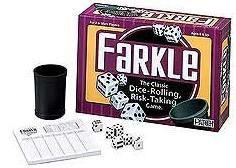Farkle or Farkel is a dice game. While the basic rules are well-established, there is a wide range of variation in both scoring and play, as described below.
Equipment
- Dice (6)
- Sheet of paper for keeping score
- Cup for shaking dice (optional)
- Flat surface to roll dice on
- Writing utensil

Play
Farkle is played by two or more players, with each player in succession having a turn at throwing the dice. Each player's turn results in a score, and the scores for each player accumulate to some winning total (usually 10,000).
- At the beginning of each turn, the player throws all six six-sided dice.
- After each throw, one or more scoring dice must be set aside (see sections on scoring below).
- The player may then either end their turn and bank the score accumulated so far, or continue to throw the remaining dice.
- If the player has scored all six dice, they have "hot dice" and may continue their turn with a new throw of all six dice, adding to the score they have already accumulated.
- If none of the dice score in any given throw, the player has "farkled" and all points for that turn are lost.
- At the end of the player's turn, the dice are handed to the next player in succession (usually in clockwise rotation), and they have their turn.
Once a player has achieved a winning point total, each other player has one last turn to score enough points to surpass that high-score.
Standard Farkle Scoring
The following scores for single dice or combinations of dice are widely established, in that they are common to all or nearly all of the above-cited descriptions of farkle scoring.
| Dice Combination | Score |
|---|---|
| Each 1 | 100 |
| Each 5 | 50 |
| Three 1's | 1000 (or 300) |
| Three 2's | 200 |
| Three 3's | 300 |
| Three 4's | 400 |
| Three 5's | 500 |
| Three 6's | 600 |
For example, if a player throws 1-2-3-3-3-5, they could do any of the following:
- score three 3's as 300 and then throw the remaining three dice
- score the single 1 as 100 and then throw the remaining five dice
- score the single 5 as 50 and then throw the remaining five dice
- score three 3's, the single 1, and the single 5 for a total of 450 and then throw the remaining die
- score three 3's, the single 1, and the single 5 for a total of 450 and stop, banking 450 points in that turn
This is not an exhaustive list of plays based on that throw, but it covers the most likely ones. If the player continues throwing, as in any of the above cases except the last, they risk farkling and thus losing all accumulated points. On the other hand, if they score five dice and have only one die to throw, they have a 1 in 3 chance of scoring a single 1 or a single 5, and then having scored all six dice they will have "hot dice" and can throw all six dice again to further increase their score. Sometimes players choose to only score with a single die in order to have a chance to score better by rethrowing the other 5 dice.
Each scoring combination must be achieved in a single throw. For example, if a player has already set aside two individual 1's and then throws a third with the four dice remaining, they do not have a triplet of 1's for a score of 1000 but merely three individual 1's for a score of 300.
Scoring Variations
Since farkle is a folk game, variant rules are used in different playing communities. While the standard rules described above are widely used, even they are not universal. For example, the commercially marketed game of Pocket Farkel differs in that three 1's are scored as 300 rather than 1000. In addition, some players score one or more combinations of dice beyond the standard ones.
- Four of a kind is scored as 1000. If the two remaining dice are a pair then score as 1500.
- Five of a kind is scored as 2000.
- Six of a kind is scored as 3000.
- A straight (1-2-3-4-5-6) is scored as 1500.
- Three pair (e.g., 1-1-4-4-6-6) is scored as 1500.
- Two triplets (e.g., 2-2-2-5-5-5) is scored as 2500.
Like the standard combinations, any of these variant combinations must be achieved in a single throw.
These are the variations listed in the above-cited descriptions of farkle scoring, but further variations presumably exist. Since it is a folk game, players are free to agree upon whatever scores they choose for whatever combinations they choose to recognize.
Play Variations
Some farkle rules also incorporate one or more of the following variations in the sequence of play.
- The first player to throw can be selected based on an initial throw of one die, with the highest die starting first.
- Players are required to achieve a threshold score of 500 in their opening turn or turns, before they can begin scoring. At the beginning of a game, each player must continue throwing in their turn until they either farkle or reach the threshold. After having reached the threshold once, they are free to stop throwing in subsequent turns whenever they choose.
- Play is almost always to 10000, but can be to 20000.
- Players may be required to make at least one additional throw when they have hot dice, even if they have accumulated a high enough score that they would choose not to risk farkling.
Adapted rules from Wikipedia, the free encyclopedia, and Patch Products version of Farkle game.